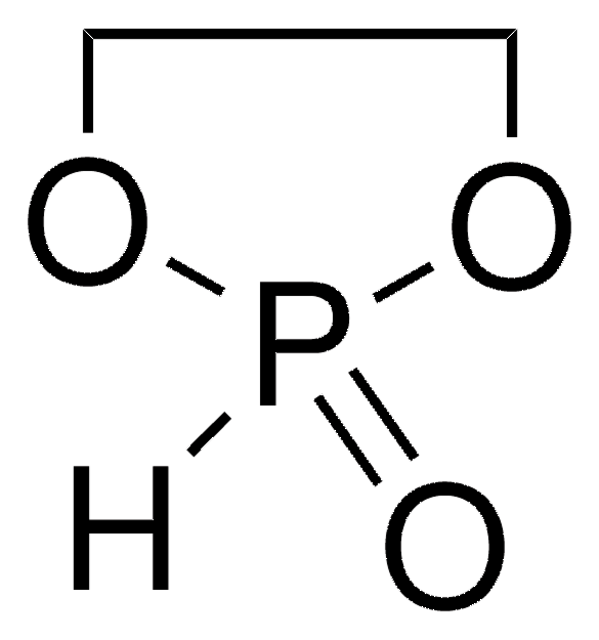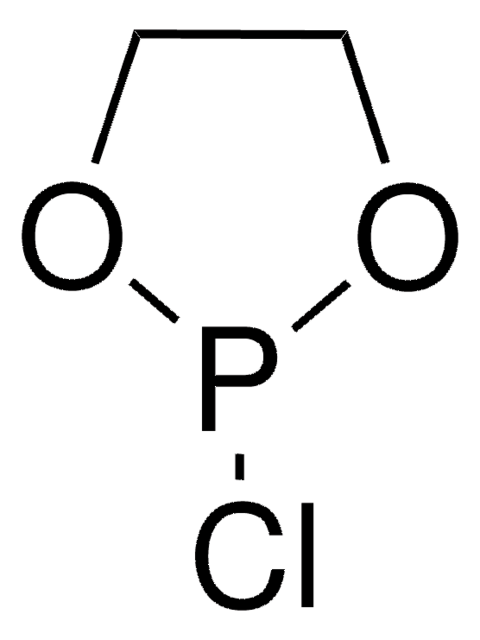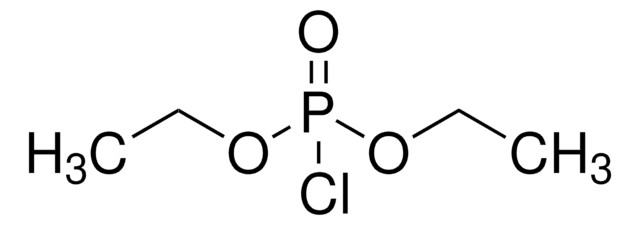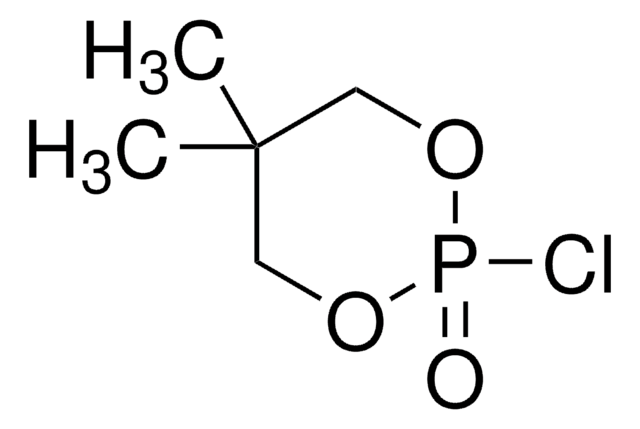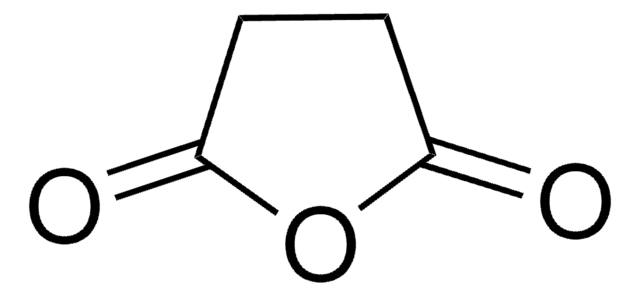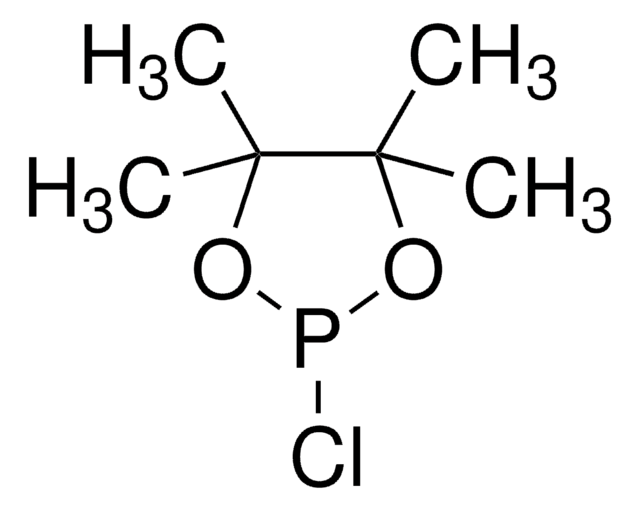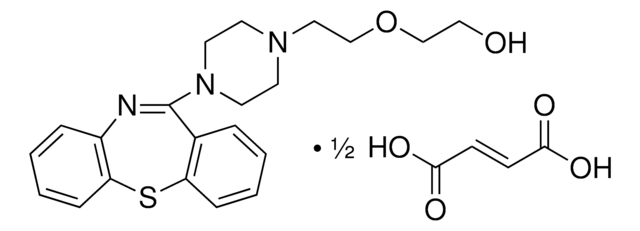377953
2-Chloro-1,3,2-dioxaphospholane 2-oxide
Synonym(s):
2-Chloro-2-oxo-1,3,2-dioxaphospholane, Ethylene glycol chlorophosphate
Sign Into View Organizational & Contract Pricing
All Photos(1)
About This Item
Empirical Formula (Hill Notation):
C2H4ClO3P
CAS Number:
Molecular Weight:
142.48
Beilstein:
606582
EC Number:
MDL number:
UNSPSC Code:
12352100
PubChem Substance ID:
NACRES:
NA.22
Recommended Products
form
liquid
Quality Level
impurities
<10% 2-Chloro-1,3,2-dioxaphospholane
refractive index
n20/D 1.45 (lit.)
bp
89-91 °C/0.8 mmHg (lit.)
mp
12-14 °C (neat) (lit.)
density
1.55 g/mL at 25 °C (lit.)
storage temp.
−20°C
SMILES string
ClP1(=O)OCCO1
InChI
1S/C2H4ClO3P/c3-7(4)5-1-2-6-7/h1-2H2
InChI key
SBMUNILHNJLMBF-UHFFFAOYSA-N
Related Categories
General description
2-Chloro-1,3,2-dioxaphospholane 2-oxide (COP) is a cyclic chlorophosphate reagent that can be prepared from 2-chloro-1,3,2-dioxaphospholane by reacting with molecular oxygen .
2-Chloro-1,3,2-dioxaphospholane 2-oxide is used in esterification reactions for cyclic phosphate synthesis, also reacts with phenyl grignard reagents.
2-Chloro-1,3,2-dioxaphospholane 2-oxide is used in esterification reactions for cyclic phosphate synthesis, also reacts with phenyl grignard reagents.
Application
2-Chloro-1,3,2-dioxaphospholane 2-oxide may be used in the synthesis of:
- 2-methacryloyloxyethylphosphorylcholine
- miltefosine (hexadecylphosphocholine, MT) analogs
- phosphoric acid 2-trimethylamino-ethyl ester undec-10-enyl ester
- uridine nucleolipid, (2′,3′-O-16-hentriacontanyliden-uridine-5′-phosphocholine, PUPC)
- adenosine nucleoamphiphile, (2′,3′-O-16-hentriacontanyliden-adenosine-5′-phosphocholine, PAPC)
- structurally related phospholipids which are either conformationally restricted or flexible
- phosphatidylcholines
Reactant for:
- Synthesis of amino-functionalized hybrid hydrocarbon/fluorocarbon double-chain phospholipid
- Synthesis of UV-polymerizable lipids via Chabrier reaction
- Syntheses of block copolymers of poly(aliphatic ester) with clickable polyphosphoester
- Imprinting molecular recognition sites on multiwalled carbon nanotubes surface for electrochemical detection of insulin in real samples
- Synthesis of a zwitterionic silane
- Synthesis of a core-shell-corona micelle stabilized by reversible cross-linkage for intracellular drug delivery
Signal Word
Danger
Hazard Statements
Precautionary Statements
Hazard Classifications
Eye Dam. 1 - Skin Corr. 1B
Supplementary Hazards
Storage Class Code
8A - Combustible corrosive hazardous materials
WGK
WGK 3
Flash Point(F)
>235.4 °F - closed cup
Flash Point(C)
> 113 °C - closed cup
Personal Protective Equipment
dust mask type N95 (US), Eyeshields, Gloves
Choose from one of the most recent versions:
Already Own This Product?
Find documentation for the products that you have recently purchased in the Document Library.
Customers Also Viewed
Toward the Efficient Synthesis of New Phosphopantothenate Derivatives by Using Chlorophosphate Reagents.
Pahor J, et al.
Synthesis, 48(21), 3763-3772 (2016)
Biomimetic honeycomb-structured surfaces formed from block copolymers incorporating acryloyl phosphorylcholine.
Stenzel MH and Davis TP.
Australian Journal of Chemistry, 56(10), 1035-1038 (2003)
Xue Jiang et al.
Nanomaterials (Basel, Switzerland), 9(2) (2019-02-16)
An efficient strategy for growing thermo-sensitive polymers from the surface of exfoliated graphene oxide (GO) is reported in this article. GO sheets with hydroxyls and epoxy groups on the surface were first prepared by modified Hummer's method. Epoxy groups on
Louis Moreau et al.
Journal of the American Chemical Society, 130(44), 14454-14455 (2008-10-15)
Supramolecular assembly formation resulting from molecular recognition between complementary nucleolipids has been visualized in real time at the micrometer scale.
Rong Yang et al.
Journal of controlled release : official journal of the Controlled Release Society, 289, 94-101 (2018-06-23)
Chemical permeation enhancers (CPEs) can enable antibiotic flux across the tympanic membrane. Here we study whether combinations of CPEs (sodium dodecyl sulfate, limonene, and bupivacaine hydrochloride) are synergistic and whether they could increase the peak drug flux. Synergy is studied
Our team of scientists has experience in all areas of research including Life Science, Material Science, Chemical Synthesis, Chromatography, Analytical and many others.
Contact Technical Service